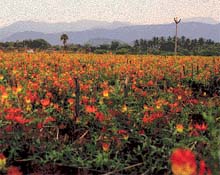A Himalayan Tragedy
 In April 1999, a director of a reputed environmental organisation in Dehradun was tipped off about 12 trucks waiting at the check-post in Dehradun. They were carrying in various quantities medicinal plants that did not feature in the list of ntfp allowed to be collected in the region comprising Uttaranchal, then a part of Uttar Pradesh. A strike had forced the trucks to halt. He tried to garner support from various quarters to take action, but to no avail. When the strike ended, the trucks loaded with the banned materials made their way through the check-post and beyond. "It is useless trying to talk to the people in the forest department or even to organisations that claim to be proactive in conservation issues,' he says.
In April 1999, a director of a reputed environmental organisation in Dehradun was tipped off about 12 trucks waiting at the check-post in Dehradun. They were carrying in various quantities medicinal plants that did not feature in the list of ntfp allowed to be collected in the region comprising Uttaranchal, then a part of Uttar Pradesh. A strike had forced the trucks to halt. He tried to garner support from various quarters to take action, but to no avail. When the strike ended, the trucks loaded with the banned materials made their way through the check-post and beyond. "It is useless trying to talk to the people in the forest department or even to organisations that claim to be proactive in conservation issues,' he says.
This is just one incident. Everyday tonnes of plants and herbs find their way out of the herb-rich state of Uttaranchal. The reasons are the same as elsewhere: a well-established nexus between forest officials, traders and the agents.
While the forests continue to get plundered, the fd has its own story to say. Every year, the fd auctions land for contract to collect certain species and pay the gatherers a stipulated amount and fd a stipulated sum of money. For more than a decade now, the contract has gone to Bhesaj Sangh, whose members include forest-dependent local people. fd 's role ends with the signing of the contract. "How they execute is their sole prerogative,' says Sunil Pande, deputy conservator of forests, Dehradun circle. So far so good. But the problem starts right thereafter.
Firstly, once Bhesaj Sangh sends the gatherers into the forests, there is no check on what is collected. The one person who is supposed to keep a tab
